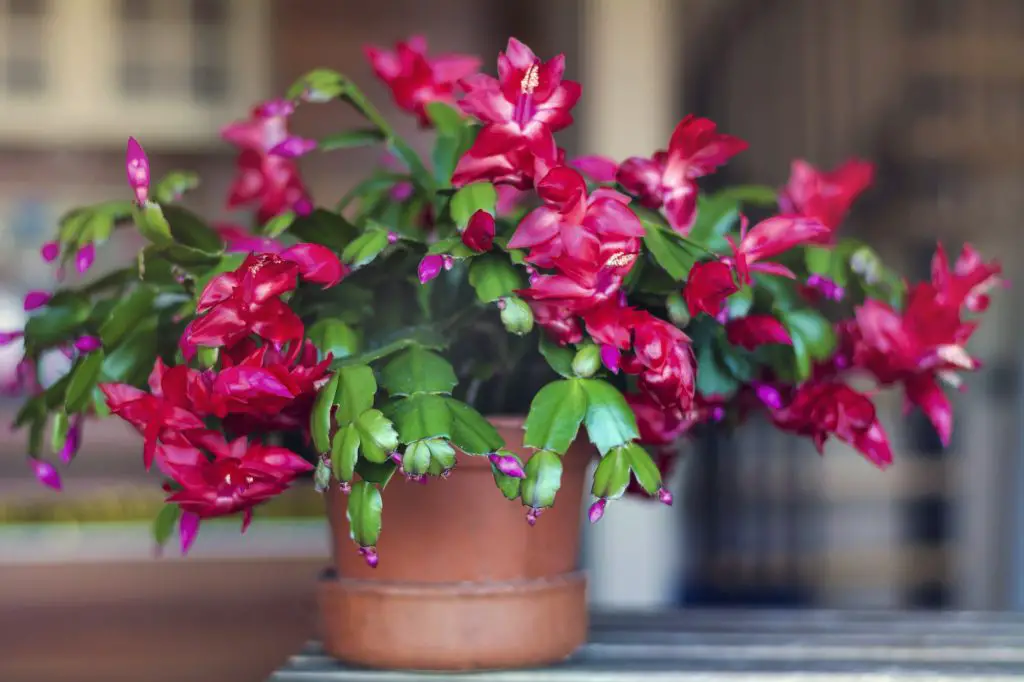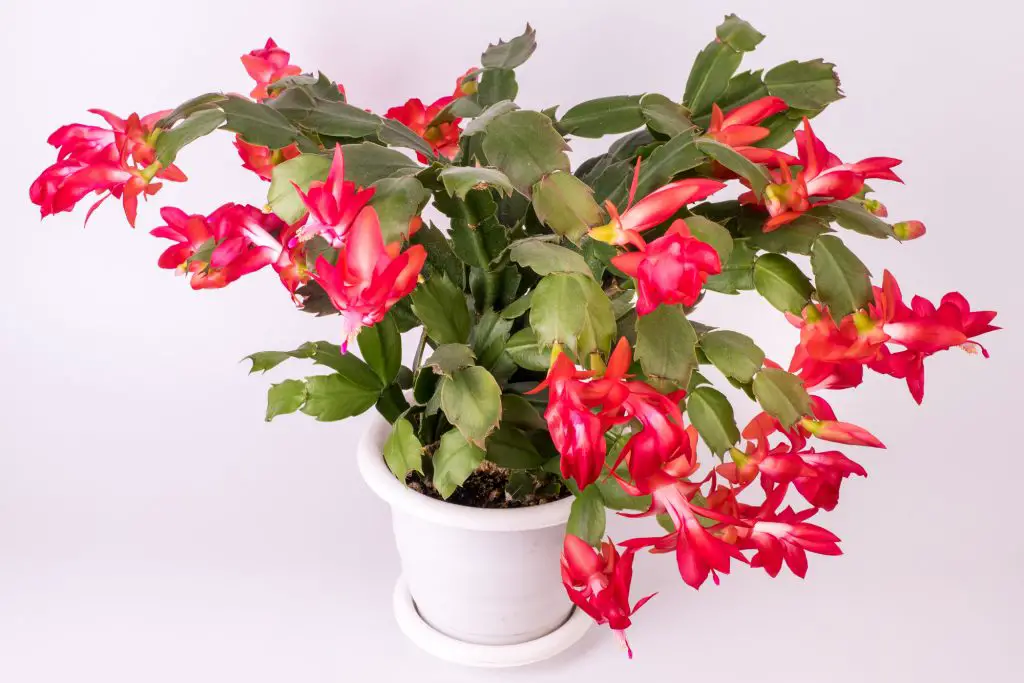Christmas Cactus is an uplifting plant to have when it is growing well. Blooming with a shock of red or pink in the winter months when other flowers have stopped producing, it brightens up long winter days. While they are stunning in good conditions, Christmas Cactus can sometimes be tricky to keep alive and get blooming.
If your Christmas Cactus is dying, try the following:
- Don’t Overwater
- Don’t Underwater
- Repot if you see root rot
- Keep in bright, indirect light
- Grow in succulent or cactus soil
- Make sure your pot has drainage
- Keep Moist
Christmas Cactus can be kind of a fussy plant, so it may take a little trial and error to get it happy enough to thrive and bloom. Read on for everything you need to know to revive a dying Christmas Cactus.
Why Is My Christmas Cactus Dying?
A dying Christmas Cactus could be due to several different reasons, so you will have to evaluate your particular plant to determine what the problem might be.
Overwatering
One common reason for Christmas Cactus dying is overwatering. Christmas Cactus is a tropical plant, though that doesn’t mean it likes for its roots to be sitting in damp soil for long periods.
Christmas Cactus is actually a succulent plant (though not a true cactus like desert cactus) and holds water in its leaves for long periods. Christmas Cactus are used to living in nutrient-poor soils that don’t retain a lot of water, so you will have to mimic that environment to avoid ending up with a dead Christmas Cactus.
Underwatering
All of that being said, Christmas Cactus is not a desert cactus and will not tolerate very dry soils the way true cactus might. Therefore, you will need to make sure your soil doesn’t dry out completely between waterings, as that might make your plant wilt and die.
Root Rot
If you see wilted or folded leaves on your Christmas Cactus, you will need to inspect its roots to see if you can identify the problem. It is possible the plant is dying due to root rot. This is caused by overwatering and improper drainage.
Root rot can be identified by black, brown, or smelly roots under the soil or just above. If the lower leaves near the soil are starting to feel mushy and look weak or dehydrated, this could be a sign of root rot.
Too Much Light
It may be easy to think that cactus are desert plants that thrive in intense sun, but this is certainly not the case with Christmas Cactus. In fact, even many desert cactus varieties prefer bright, indirect light to intense sunshine. Intense sun can cause sunburn in many succulent varieties, including Christmas Cactus.
You may notice red or purplish leaves on a sunburned Christmas Cactus.
Too Little Light
Conversely, if your Christmas Cactus is growing in low light conditions or only gets a few hours of bright light each day, this could be the reason for your dying plant.
Poor Soil
Christmas Cactus doesn’t handle stress very well, so many gardeners try to avoid repotting any more than is necessary. That being said, if your soil is old, it may be time to repot your plant in some fresh succulent or cactus soil.
Poor Drainage
Christmas Cactus roots will begin to rot if they sit in damp soil for very long. Christmas Cactus is a succulent, which means it needs to be grown in soil and a pot with good drainage–that means at least one drainage hole or more for a large pot.
Low Humidity
Christmas Cactus is a tropical plant, so it will need to grow in a slightly humid environment. If you live in a very dry climate, you may need to increase the level of humidity around the plant in order to keep it alive and get it to bloom.

Can You Revive A Wilted Christmas Cactus?
First of all, if your cactus is flowering but looks wilted, this is totally normal. The leaves will start to wilt during flowering because the plant is putting all its energy into those lovely blooms. Give it a rest for a few weeks with just a little water–it should go back to normal.
If your plant isn’t blooming and starts to wilt, drop leaves, or die, it is trying to tell you something. It may take a little while to determine the cause of the problem. Make sure you look at your plant everyday. Do the leaves look wilted? This might be due to over or underwatering.
Do the leaves look red or purple? The plant is probably getting too much sun.
Pull your plant out of its pot (gently) and check the roots. Is the plant growing out of the drainage holes in the bottom of the pot? Then it needs to be repotted in a larger pot.
Are the roots brown, black, mushy, or rotten? Then you need to trim and repot in fresh soil.
Whatever the problem is, there is a solution, and you just need to figure it out–read below for tips.
How To Revive A Christmas Cactus
Water it Correctly
The rule of thumb with Christmas Cactus (any many other succulents) is to only water when the top ⅔ of the soil is dry. You will have to test with your finger. The top of the soil should feel very dry to the touch. If you are prone to overwatering your plants, it may feel wrong at first to ignore a plant that has clearly dry soil!
Resist the temptation to water your Christmas Cactus before the soil has dried out. Most likely, it will not need to be watered as much as many other common houseplants (unless you are growing many succulents).
Let Wet Soil Dry Out
If you can tell that your soil has been sitting damp for a long time, you will need to dry out your soil and your cactus.
Remove the plant from the pot and shake as much soil as you can from the roots. You can let your plant dry out for a day or so outside its pot. Just try to keep it in the same place, so it is getting the same amount of light and heat that it is used to.
You can let the soil dry naturally if possible or repot in fresh soil. If your soil is very old, it’s a good idea to use new soil.
How to Water a Dried-Out Christmas Cactus
If you forgot to water your cactus for several weeks and now it is completely dry, you will need to slowly revive it with water. Make sure your plant is growing in sandy, coarse soil in a pot with a drainage hole.
Then you can soak the plant once a day and let the excess run out the drainage holes. This will help your plant slowly suck water back into its leaves. Don’t leave it sitting in a dish of water, or you may end up shocking the dried-out roots and causing root rot.
Check the Roots
If your plant looks like it’s dying, you may need to trim the roots. Pull your plant out of its pot and shake off the excess soil. If you see black, brown, or rotten roots, these will need to be trimmed off. Healthy roots are white, dry, and supple.
Use clean scissors or gardening shears to cut the roots. If you have root rot, make sure you wash your pot thoroughly with soap and water before repotting so that you don’t transfer any bacteria to the new soil.
Repot in Succulent or Cactus Soil
It is very important to grow succulents and cactus in the correct soil. Regular potting soil retains too much water and offers too many nutrients to these plants that are used in nutrient-poor, drier soils.
You can use pre-mixed succulent soil for Christmas Cactus or make your own. You can make soil with a mix of one-third potting soil, one-third coarse sand or gravel, and one-third pumice or perlite.
Move to a Larger Pot
If your plant used to thrive in its current spot, and you feel you have been watering it correctly, it may be wilting frequently because it needs to be moved to a larger pot (or divided into smaller pots).
If the plant’s roots are growing out of the drainage holes, it is definitely time to repot. Choose a new pot around one inch larger than the old pot. If your plant is very large, there are several ways of propagating a Christmas Cactus.
Move to Better Light
If you need to move your plant to a brighter (or lower-light) location, make sure you do so gradually, giving it a few hours each day in the new environment so it can adjust appropriately.
If your cactus is getting several hours of full, bright sun each day, you may want to move it a little farther from the window or into a place where it can get some shade. If you can, hang a sheer curtain in the window to protect the plant from getting too much light.
Morning sun is often ok for succulents, as it is not as intense as the noon or afternoon sun.
If your Christmas Cactus is growing in a very dark corner, try moving it to a brighter spot and see if that improves its condition. If you don’t have bright light, you can try a grow light.
Keep Humid
If you live in a very dry climate, try putting a pebble tray under the plant. Keep water in the tray to humidify the plant (but don’t let the pot sit in water). You can also place your Christmas Cactus in the kitchen or bathroom, where it will naturally get more humidity.
How To Revive A Very Old Christmas Cactus
Christmas Cactus can live for a very long time (some over 100 years!). Many are passed down through generations. If you have inherited a Christmas Cactus that used to be thriving and now needs some TLC, here are some ideas to revive an old Christmas Cactus.
Repot Christmas Cactus in Fresh Soil
If your plant has been sitting in the same soil for several years, it is time to repot. Use pre-mixed or homemade succulent or cactus soil. Make sure to shake off all the excess old soil.
It is typically a good idea to repot your Christmas Cactus every 3-5 years. Some plants may get very large. If so, make sure you give them large enough pots that the roots are not growing out of the holes and there is adequate soil covering the roots.
Divide Large Plants
If your plant has outgrown its pot, you may want to place it in a pot one inch larger than the old pot. If it is very large, you can divide it into smaller plants and plant them in small pots. This is best done in late spring, if possible.
Prune After Blooming
If your plant was healthy enough to bloom, you could keep it healthy by pruning it one month after bloom, so it starts new growth. Just pinch off a few sections of leaf on each branch. You can use these to propagate new plants.
Fertilize During Growing Season
Most plants only need regular fertilizer during the summer growing season. Some gardeners also fertilize Christmas Cactus in the winter after blooming in order to encourage further flowering, though your plant should be fine with regular fertilizing in the summer months.
Keep Away From Drafts and Intense Sun
Your plant has survived for this long, but it may get fussier as it gets older. Make sure you keep Christmas Cactus away from temperature swings, HVAC vents, and drafty windows and doors. If your plant is outdoors, bring it inside before the temperature dips below around 50 degrees F.
Conclusion
As succulents go, Christmas Cactus can be one of the trickier ones to get the hang of, but if you persevere and really watch your plant, you will be able to solve any issues that arise. Not only will you be a pro at reviving a Christmas Cactus–you may even be able to coax your plant into blooming every year for Christmas.







